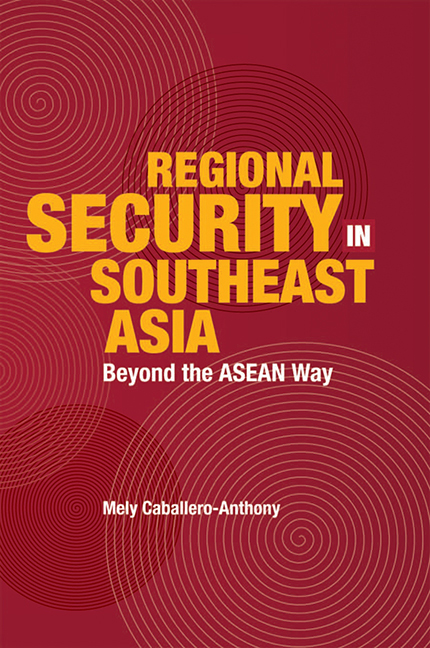Book contents
- Frontmatter
- Contents
- Acknowledgements
- INTRODUCTION: Regional Security in Southeast Asia: Beyond the ASEAN Way
- 1 Regionalism and Regional Security: Locating ASEAN
- 2 ASEAN's Mechanisms of Conflict Management: Revisiting the ASEAN Way
- 3 ASEAN and the Cambodian Conflict: Testing the Limits of the ASEAN Way
- 4 ASEAN Regional Forum: Extending the ASEAN Way in Managing Regional Order
- 5 ASEAN's Track Two Diplomacy: Reconstructing Regional Mechanisms of Conflict Management
- 6 The Asian Economic Crisis and Other Challenges: Turning Points Beyond the Comfort Zone?
- 7 ASEAN and Civil Society: Enhancing Regional Mechanisms for Managing Security
- 8 Conclusion: Beyond the ASEAN Way
- APPENDIX I Declaration of ASEAN Concord II (Bali Concord II)
- APPENDIX II Recommendations of the High-Level Task Force on ASEAN Economic Integration
- APPENDIX III ASEAN Vision 2020
- APPENDIX IV Declaration of ASEAN Concord
- Selected References and Further Readings
- Index
- About the Author
2 - ASEAN's Mechanisms of Conflict Management: Revisiting the ASEAN Way
Published online by Cambridge University Press: 21 October 2015
- Frontmatter
- Contents
- Acknowledgements
- INTRODUCTION: Regional Security in Southeast Asia: Beyond the ASEAN Way
- 1 Regionalism and Regional Security: Locating ASEAN
- 2 ASEAN's Mechanisms of Conflict Management: Revisiting the ASEAN Way
- 3 ASEAN and the Cambodian Conflict: Testing the Limits of the ASEAN Way
- 4 ASEAN Regional Forum: Extending the ASEAN Way in Managing Regional Order
- 5 ASEAN's Track Two Diplomacy: Reconstructing Regional Mechanisms of Conflict Management
- 6 The Asian Economic Crisis and Other Challenges: Turning Points Beyond the Comfort Zone?
- 7 ASEAN and Civil Society: Enhancing Regional Mechanisms for Managing Security
- 8 Conclusion: Beyond the ASEAN Way
- APPENDIX I Declaration of ASEAN Concord II (Bali Concord II)
- APPENDIX II Recommendations of the High-Level Task Force on ASEAN Economic Integration
- APPENDIX III ASEAN Vision 2020
- APPENDIX IV Declaration of ASEAN Concord
- Selected References and Further Readings
- Index
- About the Author
Summary
INTRODUCTION
This chapter will discuss the evolution of ASEAN's mechanisms of conflict management (CM) by providing a historical narrative of ASEAN's development as a regional organization. In revisiting these mechanisms, it is useful to bear in mind the various kinds of techniques and strategies that regional organizations use to manage or resolve conflict as discussed in the previous chapter. To reiterate, these mechanisms range from: norm-building, assurance, community-building, deterrence, nonintervention, isolation, intervention, and internationalization.
Before we begin, it is helpful to highlight a number of significant points to consider in examining the way mechanisms are developed and how these mechanisms are used to manage conflicts. The first point to note is the classification of these various types of mechanisms. These mechanisms of CM can either be formally based on institutionalized methods or adopted informally with co-operation being tacit among member parties. A combination of both formal and informal methods can also be used. The next point to consider is that regardless of whether the mechanisms are formal or informal in nature, what is significant in assessing these mechanisms is the choice of which mechanism to deploy in certain times of crises. In this regard, the choice would also very much depend on the nature of the conflict itself and the kind of outcome desired.
The third point to note is the feasibility of these mechanisms in practice and their relevance in managing conflicts at both domestic and regional levels. Muthiah Alagappa, whose classification of the types of mechanisms of CM formed the basis of this study, noted that while there is a range of mechanisms that should be easily available to regional organizations — given the kind of communication and socialization that takes place among them — one needs to focus on the more important questions of whether these mechanisms are feasible in practice and whether these mechanisms are relevant in the context wherein they are used. In this regard, one might realize that for most regional organizations, choosing and determining which mechanisms are feasible and relevant would often be dependent on their respective institutional capacity.
- Type
- Chapter
- Information
- Regional Security in Southeast AsiaBeyond the ASEAN Way, pp. 49 - 82Publisher: ISEAS–Yusof Ishak InstitutePrint publication year: 2005



